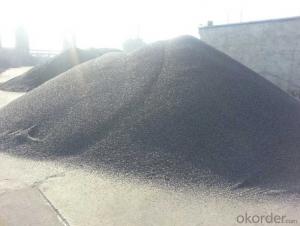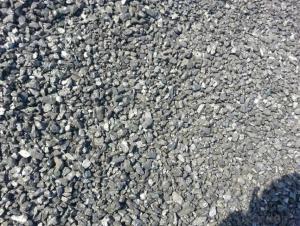Injection carbon FC90 with high and stable quality
- Loading Port:
- Tianjin
- Payment Terms:
- TT OR LC
- Min Order Qty:
- 20 m.t.
- Supply Capability:
- 3000 m.t./month
OKorder Service Pledge
OKorder Financial Service
You Might Also Like
Packaging & Delivery
25kgs/50kgs/1ton per bag or as buyer's request
Specifications
Calcined Anthracite
Fixed carbon: 90%-95%
S: 0.5% max
Size: 0-3. 3-5.3-15 or as request
It used the high quality anthracite as raw materials through high temperature calcined at over 2000 by the DC electric calciner with results in eliminating the moisture and volatile matter from anthracite efficiently, improving the density and the electric conductivity and strengthening the mechanical strength and anti-oxidation. It has good characteristics with low ash, low resistvity, low sulphur, high carbon and high density. It is the best material for high quality carbon products.
Advantage and competitive of caclined anthracite:
1. strong supply capability
2. fast transportation
3. lower and reasonable price for your reference
4.low sulphur, low ash
5.fixed carbon:95% -90%
6..sulphur:lower than 0.3%
General Specification of Calcined Anthracite:
| FC | 95 | 94 | 93 | 92 | 90 |
| ASH | 4 | 5 | 6 | 6.5 | 8.5 |
| V.M. | 1 | 1 | 1 | 1.5 | 1.5 |
| S | 0.3 | 0.3 | 0.3 | 0.35 | 0.35 |
| MOISTURE | 0.5 | 0.5 | 0.5 | 0.5 | 0.5 |
Pictures

- Q: What is carbon nanosensor?
- Utilizing carbon-based materials at the nanoscale, a carbon nanosensor is designed to detect and measure various substances or physical properties. These sensors possess a high sensitivity and are incredibly small, enabling them to detect even the tiniest amounts of target molecules or changes in their surroundings. By functionalizing the surface of the carbon nanomaterials with specific receptors or probes, carbon nanosensors can be tailored to target specific molecules or properties. Furthermore, integration with other technologies, like electronics, allows for real-time monitoring and data analysis. Carbon nanomaterials possess unique properties, such as high surface area, electrical conductivity, and chemical stability, that render them perfect for constructing versatile and sensitive sensors applicable in a wide range of fields, including environmental monitoring, medical diagnostics, and food safety.
- Q: How does deforestation contribute to carbon dioxide levels in the atmosphere?
- Deforestation plays a significant role in contributing to increased carbon dioxide levels in the atmosphere. Trees act as natural carbon sinks, absorbing carbon dioxide during photosynthesis and storing it in their trunks, branches, and leaves. When forests are cleared or burned down for various purposes such as agriculture, logging, or urbanization, the stored carbon is released back into the atmosphere as carbon dioxide. The removal of trees directly leads to a reduction in the planet's capacity to absorb carbon dioxide, resulting in an imbalance in the carbon cycle. Additionally, deforestation disrupts the carbon cycle by inhibiting the process of photosynthesis, which is essential for converting carbon dioxide into oxygen and organic compounds. Moreover, deforestation indirectly contributes to increased carbon dioxide levels in the atmosphere through the decomposition of organic matter. When trees are cut down or burned, the stored carbon they contain is released into the atmosphere as carbon dioxide, intensifying greenhouse gas emissions. Furthermore, deforestation also impacts the water cycle, leading to drier conditions in the affected areas. This dries out the soil, making it less suitable for plant growth and reducing the potential for carbon absorption through reforestation efforts. The cumulative effect of deforestation on carbon dioxide levels is significant. According to studies, deforestation accounts for approximately 10-15% of global carbon emissions, making it one of the leading contributors to climate change. The increase in atmospheric carbon dioxide levels, along with other greenhouse gases, contributes to the greenhouse effect, trapping heat in the atmosphere and causing global warming. Addressing deforestation is crucial in mitigating climate change and reducing carbon dioxide levels. Implementing sustainable forestry practices, promoting reforestation efforts, and protecting existing forests are essential steps in preserving carbon sinks and reducing greenhouse gas emissions.
- Q: What are the different types of carbon-based plastics?
- There are several types of carbon-based plastics, including polyethylene (PE), polypropylene (PP), polyvinyl chloride (PVC), polystyrene (PS), and polyethylene terephthalate (PET). Each of these plastics has unique properties and applications, making them suitable for various industries and products.
- Q: What are the effects of carbon emissions on the stability of coastal ecosystems?
- Coastal ecosystems are significantly affected by carbon emissions, resulting in various consequences. Ocean acidification, caused by excess carbon dioxide dissolving in seawater and lowering its pH, is one of the primary effects. This acidification harms marine organisms, especially those dependent on calcium carbonate for shell formation, such as corals, oysters, and some plankton. With increased acidity, the ability of these organisms to create and maintain their protective structures is hindered, leading to slower growth, weaker shells, and heightened vulnerability to predation and disease. Furthermore, global warming, which is exacerbated by carbon emissions, leads to rising sea levels and more intense storms. Coastal ecosystems like mangroves, salt marshes, and seagrass beds serve as barriers against storm surges and provide vital habitats for numerous species. However, as sea levels rise, these ecosystems face the risk of submersion, resulting in the loss of their protective functions and the displacement of various plant and animal species. In addition, carbon emissions-driven climate change disrupts ocean currents and disturbs nutrient balances in coastal waters. This disturbance can cause shifts in the distribution and abundance of marine species, affecting the entire food chain. For example, if certain species that serve as prey or predators are negatively impacted, it can create a ripple effect throughout the ecosystem. These disruptions ultimately lead to reduced biodiversity, the loss of crucial species, and the potential collapse of entire coastal ecosystems. To safeguard these fragile ecosystems and the countless species that depend on them, it is imperative to reduce carbon emissions and mitigate the impacts of climate change.
- Q: What's the difference between coal and carbon?
- Coal is the main component of carbon, carbon in addition to coal, as well as graphite, diamonds and so on
- Q: What are the consequences of increased carbon emissions on tourism industry?
- The consequences of increased carbon emissions on the tourism industry include the deterioration of natural attractions, such as coral reefs and glaciers, which are major tourist draws. Additionally, extreme weather events and rising sea levels can damage infrastructure and disrupt travel plans. The industry may also face increased regulations and taxes aimed at reducing carbon emissions, leading to higher operational costs for businesses. Overall, the consequences of increased carbon emissions on the tourism industry are detrimental to both the environment and the economy.
- Q: when to use hard carbon, and when to use soft carbon. Neutral charcoal can play what role? Thank you.
- Hard charcoal first used to draft the draft, then is depicted. On the tone of most people love compared with neutral charcoal, personal love. At the end of the characterization, soft and hard together. That's probably it.
- Q: What are the effects of carbon emissions on the stability of peatlands?
- Carbon emissions have significant effects on the stability of peatlands. Increased levels of carbon dioxide in the atmosphere contribute to global warming, which in turn accelerates the decomposition of organic matter in peatlands. This decomposition releases even more carbon dioxide, creating a positive feedback loop that further exacerbates climate change. Additionally, rising temperatures and changing precipitation patterns can lead to the drying out of peatlands, making them more prone to wildfires. These fires release massive amounts of carbon dioxide into the atmosphere, further contributing to climate change. Overall, carbon emissions threaten the stability of peatlands by accelerating their degradation and releasing large amounts of greenhouse gases.
- Q: What are the impacts of carbon emissions on the stability of kelp forests?
- Kelp forests are significantly affected by carbon emissions, which have a major impact on their stability. The increased levels of carbon dioxide in the atmosphere lead to ocean acidification, causing harmful effects on kelp. When carbon dioxide dissolves in seawater, it creates carbonic acid, which lowers the ocean's pH. This acidification prevents kelp from growing and developing properly, making them more vulnerable to stressors and reducing their overall stability. Ocean acidification affects kelp physiology in various ways. It impairs their ability to absorb essential nutrients like nitrogen and phosphorus, which are crucial for their growth. This nutrient deficiency weakens the kelp, making them more susceptible to diseases, predation, and damage from storms. Moreover, acidified seawater hinders the development of kelp spores, which impairs their ability to reproduce and regenerate kelp forests. Furthermore, carbon emissions contribute to the increase in sea temperatures, which also harm kelp forests. As the climate warms, kelp may face thermal stress, resulting in slower growth rates and higher mortality rates. Warmer waters also create favorable conditions for harmful algae species, which can outcompete kelp for space and resources, further destabilizing kelp forests. The stability of kelp forests is crucial because they provide numerous ecosystem services. They act as important carbon sinks, absorbing and storing large amounts of carbon dioxide from the atmosphere. Kelp forests also serve as habitats and nursery grounds for a wide range of marine species, including commercially important fish and invertebrates. They play a vital role in maintaining the health and productivity of coastal ecosystems by reducing coastal erosion, improving water quality, and supporting biodiversity. To mitigate the impacts of carbon emissions on kelp forests, it is crucial to reduce our carbon footprint by transitioning to cleaner and more sustainable energy sources. Additionally, protecting and restoring coastal habitats, including kelp forests, can enhance their resilience to climate change and other stressors. Implementing sustainable fishing practices and establishing marine protected areas can also help preserve and maintain the stability of kelp forests and the valuable ecosystem services they provide.
- Q: Carbon Finance: Carbon Finance
- The "Framework Convention" is the world's first comprehensive control of carbon dioxide and other greenhouse gas emissions, the International Convention for the human economic and social adverse effects in response to global warming, a basic framework is also the international society for international cooperation in tackling global climate change on the issue. According to statistics, 191 countries have ratified the Convention at present. These countries are called parties to the convention. The parties to the Convention have made many pledges aimed at addressing climate change. Each party must submit periodic reports, which contain the greenhouse gas emission information of the contracting parties and indicate plans and specific measures for the implementation of the convention. The Convention came into force in March 1994 and laid the legal foundation for international cooperation in dealing with climate change. It was an authoritative, universal and comprehensive international framework. The Convention consists of a preamble and 26 main texts. The Convention is legally binding to control emissions of carbon dioxide, methane and other greenhouse gases in the atmosphere and stabilize the concentration of greenhouse gases from the destruction of the climate system. The Convention differs from the developed countries and developing countries in terms of their obligations and procedures for fulfilling their obligations.
Send your message to us
Injection carbon FC90 with high and stable quality
- Loading Port:
- Tianjin
- Payment Terms:
- TT OR LC
- Min Order Qty:
- 20 m.t.
- Supply Capability:
- 3000 m.t./month
OKorder Service Pledge
OKorder Financial Service
Similar products
Hot products
Hot Searches


























